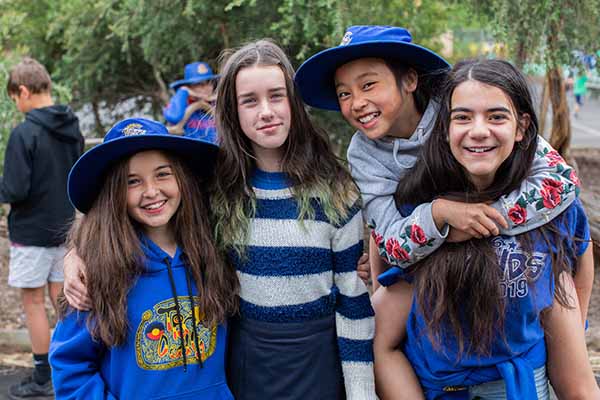Overview
Alignment with Be You Domains
-
Mentally Healthy Communities
Alignment with Early Years Learning Framework (EYLF)
- Children are confident and involved learners
- Children are connected with and contribute to their world
- Children are effective communicators
- Children have a strong sense of identity
- Children have a strong sense of wellbeing
Alignment with Australian Curriculum
- Health and PE
Target audience
- Primary school
Target groups
- Small group
- Whole class
Aims
The Sparky and Shady for Big Kids program aims to provide a framework for children to understand their loving and scared sides so they are empowered to meet their needs in positive ways; to give children knowledge, understanding and strategies to manage their body, personality, thoughts, feelings and behaviours; to give children strategies to cope with problems such as bullying, anxiety and other challenges they may face; to empower children with the courage and confidence they need to believe in themselves, follow their dreams and make a positive difference in the world.Program theory
The program is based on humanistic psychology (that human beings have needs as outlined by Maslow's hierarchy of needs; that they have choice or free will as to how they meet their needs); psychodynamic psychology (that beliefs in a human being's subconscious mind, based on past thoughts, feelings, and experiences, affect their choices and behaviour), cognitive psychology (people can choose what they learn from their experiences, and that prior learning can be built upon); and positive psychology (that a person's wellbeing is determined by meaning, pleasure, engagement, positive relationships and accomplishment).Topics
There are 9 chapters in the book: 1. Who you are 2. Why you are here 3. How your body works 4. How your personality works 5. How your thoughts work 6. How your feelings work 7. How to cope with problems 8. How to believe in yourself 9. How to follow your dreams.Cost
Program structure
There are 18 sessions. Twice weekly, 20 to 30 minutes per lesson.Instructor
- Educator
Instructor training
Read the book and Teacher's Manual before presenting the content to children.Supporting resources or materials available with program
- Manual
- Online webinars
- Posters
- Workbook
Ongoing support
Email and website.Parent involvement
- Follow-up information provided after program
- Written information provided to parents
Origin of program
Australia
Sparky and Shady
Program authors
Kathy Sheehan
- 5 Harbour Drive,Coffs Harbour NSW 2450 Australia
Ratings
Summary of evidence factors
This is a summary of the evaluation or research study characteristics that contribute to the program’s evidence rating.
|
Positive impact on at least one outcome for children and/or young people?
The study reported positive outcomes. |
No |
|---|---|
|
Link between program description and theory of change
Theory of change refers to whether there was a comprehensive description and illustration of how and why a desired change is expected to happen in a particular context. |
Comprehensive |
|
Study design
Type of study design reported. |
Pre-post cohort |
|
Independence
The degree to which the program authors were involved in the research. |
None |
Summary of implementation factors
This is a summary of the program’s characteristics that contribute to its implementation rating.
|
Feedback sought from participants
Participants enjoyed the program and understood its benefits. |
Yes |
|---|---|
|
Feedback sought from instructors
Instructors enjoyed the program and understood its benefits. |
Yes |
|
Groups program is not suitable for
Groups the program wouldn't be suitable for or that required further research to determine suitability. |
Not assessed |
|
Training provided during study
The model of training provided. |
None |
|
Ongoing instructor support provided during study
Whether ongoing support is provided. |
Yes |
Context
This is a summary of the context in which the evidence for the program was established.
|
Study Participants
Pre school, primary school (Foundation to Year 6), secondary school (Years 7 to 12). |
Primary school |
|---|---|
|
Country of Study/s
The location in which the evidence or research was conducted. |
Australia |
|
Location of Study/s in Australia
The state (or states) the program was assessed in Australia. |
NSW |
|
Evaluation of program in culturally and linguistically diverse populations
Provider has included culturally and linguistically diverse people when assessing the program. |
Yes |
|
Evaluation of program in Aboriginal and Torres Strait Islander children and young people
Provider has included Aboriginal and Torres Strait Islander peoples when assessing the program. |
Yes |
|
Evaluation of program in low socioeconomic groups
Program has evaluated a diverse socio-economic population in their research. |
No |
|
Developmental based adaptations to program design and delivery
Shorter sessions for younger students or activities are adjusted for age appropriateness. |
Yes |
|
Evaluation of program in children and young people with disability and/or learning difference
Provider has included participants with a disability or learning difference when assessing the program. |
No |
Last updated: 19 November 2021
